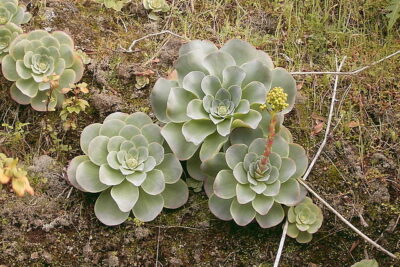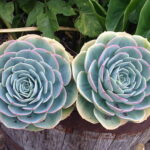
Can a Violet Queen Succulent Thrive Indoors? Tips for Indoor Care

Violet Queen succulents, also known as Echeveria 'Violet Queen', are a popular choice among succulent enthusiasts for their stunning colors and unique rosette shape. These plants are native to Mexico and are prized for their ability to thrive in arid conditions. While they are commonly grown outdoors, many people wonder if it is possible to successfully grow a Violet Queen succulent indoors. We will explore the factors to consider when caring for a Violet Queen succulent indoors, and provide helpful tips to ensure its health and longevity.
Indoor gardening can present its own set of challenges, especially when it comes to succulents. We will discuss the ideal growing conditions for a Violet Queen succulent indoors, including lighting, temperature, and humidity requirements. We will also provide tips on watering, soil selection, and fertilization to help you create the perfect environment for your indoor succulent. Additionally, we will address common issues that may arise when growing a Violet Queen succulent indoors, such as pests and diseases, and offer guidance on how to prevent and treat these problems. By following our expert tips and advice, you can enjoy the beauty of a thriving Violet Queen succulent in your indoor space.
- Yes, a Violet Queen succulent can thrive indoors with proper care
- Place the succulent in a well-lit area, preferably near a window with bright, indirect sunlight
- Ensure the succulent is in a well-draining potting mix to prevent root rot
- Water the plant thoroughly but allow the soil to dry out between waterings
- Provide bright indirect sunlight for optimal growth
- Use well-draining soil and a suitable container
- Provide proper humidity levels and temperature
- Avoid overwatering, as this can lead to root rot
- Use a balanced fertilizer during the growing season to provide nutrients
- Maintain a moderate room temperature, ideally between 65-75°F (18-24°C)
- Protect the succulent from extreme temperature fluctuations and drafts
- Rotate the plant occasionally to ensure even growth and prevent leaning
- Keep an eye out for pests such as mealybugs or aphids and treat them promptly if detected
- Trim any dead or yellow leaves to maintain the overall health and appearance of the plant
- Enjoy the beauty of your thriving indoor Violet Queen succulent
- Frequently Asked Questions
Yes, a Violet Queen succulent can thrive indoors with proper care
Indoor gardening has become increasingly popular, and succulents are among the most sought-after plants for indoor spaces. If you are a fan of succulents and wondering if a Violet Queen succulent can thrive indoors, the answer is a resounding yes! With the right conditions and care, your Violet Queen succulent can flourish and bring a touch of beauty to your indoor environment.
Understanding the Violet Queen succulent
The Violet Queen succulent, also known as Echeveria 'Violet Queen', is a stunning plant that belongs to the Echeveria family. It is characterized by its rosette-shaped, fleshy leaves that exhibit a mesmerizing blend of purple and blue hues. This eye-catching succulent can add a pop of color and elegance to any indoor setting, making it a popular choice among succulent enthusiasts.
Creating the ideal environment
For your Violet Queen succulent to thrive indoors, it is crucial to recreate the ideal environment it naturally thrives in. Here are some key factors to consider:
- Light: Violet Queen succulents require bright, indirect sunlight to grow properly. Place them near a south or east-facing window where they can receive at least four to six hours of sunlight daily. If direct sunlight is unavoidable, provide some shade during the hottest parts of the day to prevent sunburn.
- Temperature: These succulents prefer moderate temperatures ranging from 65°F to 75°F (18°C to 24°C). Avoid placing them in areas with extreme temperature fluctuations or near drafts.
- Humidity: Violet Queen succulents thrive in dry environments, so it is important to keep humidity levels low. Avoid placing them in areas with high humidity, such as bathrooms or kitchens.
- Soil: Use a well-draining succulent or cactus soil mix to ensure proper drainage and prevent root rot. You can also add perlite or sand to improve drainage.
- Watering: Succulents, including the Violet Queen, are adapted to survive in arid conditions and have low water requirements. Water your Violet Queen sparingly, allowing the soil to dry out completely between waterings. Overwatering can lead to root rot, which is detrimental to the plant's health.
By providing the right lighting, temperature, humidity, soil, and watering regimen, you can create an ideal environment for your Violet Queen succulent to thrive indoors.
 Indoor or Outdoor: Choosing the Right Environment for Your Succulents
Indoor or Outdoor: Choosing the Right Environment for Your SucculentsCaring for your Violet Queen succulent
Aside from providing the ideal environment, there are a few additional care tips to keep in mind:
- Fertilization: Feed your Violet Queen succulent with a balanced, diluted succulent fertilizer during the growing season (spring and summer) to promote healthy growth. Follow the instructions on the fertilizer packaging for the correct dosage.
- Pruning: Remove any dead or withered leaves to maintain the plant's overall health and appearance. Be careful not to damage the healthy leaves or stem while pruning.
- Propagation: If you want to expand your succulent collection or share it with others, you can propagate your Violet Queen succulent through leaf or stem cuttings. Allow the cuttings to callus for a few days before planting them in well-draining soil.
With these care tips and a little love, your Violet Queen succulent will thrive indoors and continue to enchant you with its vibrant colors and unique form.
Place the succulent in a well-lit area, preferably near a window with bright, indirect sunlight
If you are considering bringing a Violet Queen Succulent indoors, it is important to provide it with the right conditions to thrive. One of the most crucial factors for indoor care is proper lighting.
Place the succulent in a well-lit area, preferably near a window with bright, indirect sunlight. This will allow the plant to receive the necessary amount of light without being exposed to direct harsh rays that can damage its leaves.
Indoor lighting can sometimes be insufficient, especially during the winter months or if your home doesn't have many windows. In such cases, you can supplement natural light with artificial grow lights. Opt for full spectrum LED lights that mimic natural sunlight. Place the grow lights about 6-12 inches above the plant to ensure adequate light penetration.
In addition to proper lighting, temperature is another important consideration for the Violet Queen Succulent. It is native to warm climates, so aim to keep the indoor temperature between 65-80°F (18-27°C). Avoid placing the plant near drafty windows or air conditioning vents as sudden temperature changes can stress the succulent.
When it comes to watering, the Violet Queen Succulent is a drought-tolerant plant. Overwatering can lead to root rot and other issues. Allow the top inch of soil to dry out between waterings. Always check the moisture level by sticking your finger into the soil before watering.
 Can Succulents Survive Outdoors Year-Round?
Can Succulents Survive Outdoors Year-Round?During the growing season, which typically spans from spring to fall, fertilize the succulent once every month. Use a balanced, water-soluble fertilizer diluted to half strength. This will provide the necessary nutrients for healthy growth.
It is important to note that the Violet Queen Succulent is a slow grower. Don't be alarmed if you don't see rapid growth. Patience is key when it comes to succulent care.
For a Violet Queen Succulent to thrive indoors:
- Place it in a well-lit area with bright, indirect sunlight
- Consider supplementing natural light with artificial grow lights
- Maintain a temperature between 65-80°F (18-27°C)
- Water sparingly, allowing the top inch of soil to dry out between waterings
- Fertilize once a month during the growing season
- Be patient, as the succulent is a slow grower
By following these tips and providing the proper care, you can enjoy the beauty of a thriving Violet Queen Succulent right in your own home.
Ensure the succulent is in a well-draining potting mix to prevent root rot
Can a Violet Queen Succulent Thrive Indoors? Tips for Indoor Care
When it comes to growing a Violet Queen succulent indoors, providing the right care is crucial for its thriving. One of the most important aspects to consider is the potting mix used for this beautiful plant.
A well-draining potting mix is essential for the health of your Violet Queen succulent. This type of succulent prefers soil that allows excess water to drain quickly, preventing the roots from sitting in damp conditions for too long. To achieve this, you can create a custom potting mix by combining equal parts of sandy soil, perlite, and peat moss. Alternatively, you can purchase a pre-made cactus and succulent soil mix from your local garden center.
 Indoor Succulent Care: Expert Tips for Blue Succulents
Indoor Succulent Care: Expert Tips for Blue SucculentsWhen repotting your Violet Queen succulent, make sure to choose a pot with drainage holes. These holes allow excess water to escape, further preventing the risk of root rot. Additionally, using a pot with a size slightly larger than the current one will allow your succulent to have enough space to grow.
Remember to water your Violet Queen succulent only when the top inch of the soil feels dry. Overwatering can lead to root rot, which is a common issue for succulents. By using a well-draining potting mix and being mindful of watering, you can help your Violet Queen succulent thrive indoors.
Water the plant thoroughly but allow the soil to dry out between waterings
When it comes to caring for a Violet Queen Succulent indoors, one of the most important factors to consider is watering. While these plants require regular watering, it is crucial to ensure that the soil is allowed to dry out between waterings.
When watering your Violet Queen Succulent, it is essential to give it a thorough soak. Water the plant until you see water draining out from the bottom of the pot. This ensures that the entire root system is getting adequately hydrated.
However, it is equally important to let the soil dry out between waterings. Overwatering can lead to root rot and other issues that can harm your succulent. To determine when to water your Violet Queen Succulent again, check the moisture level of the soil by inserting your finger about an inch deep. If it feels dry, it is time to water. If the soil still feels moist, wait a few more days before watering.
Remember, succulents are adapted to survive in arid conditions, and they store water in their leaves and stems. Therefore, they can tolerate drought better than excessive moisture.
Provide bright indirect sunlight for optimal growth
Violet Queen Succulents thrive in bright indirect sunlight. Although they can tolerate some direct sunlight, it is best to provide them with indirect light to prevent leaf burn and overheating.
 Indoor or Outdoor: Maximizing Succulent Growth for Optimal Results
Indoor or Outdoor: Maximizing Succulent Growth for Optimal ResultsPlace your succulent near a south or west-facing window where it can receive bright, filtered light. If you don't have access to ample natural light, you can also use artificial grow lights to supplement the lighting requirements of your Violet Queen Succulent.
Keep in mind that while these plants love sunlight, prolonged exposure to intense, direct sunlight can cause damage to their leaves. If you notice signs of sunburn, such as brown or yellow spots on the leaves, move your succulent to a shadier location.
Use well-draining soil and a suitable container
Choosing the right soil and container is crucial for the overall health and growth of your Violet Queen Succulent. These plants require well-draining soil to prevent waterlogged roots.
When selecting potting soil, opt for a well-draining blend specifically formulated for succulents or cacti. These mixes typically contain a combination of organic materials, such as peat moss and perlite, to promote proper drainage.
Additionally, ensure that the pot you choose has drainage holes at the bottom. This allows excess water to escape and prevents the plant from sitting in standing water, which can lead to root rot.
Provide proper humidity levels and temperature
Violet Queen Succulents prefer average to low humidity levels. Avoid placing your succulent in areas with high humidity, such as bathrooms or kitchens, as it can lead to fungal diseases.
As for temperature, these succulents thrive in temperatures between 60°F to 80°F (15°C to 27°C). Avoid exposing them to extreme fluctuations in temperature, as it can cause stress and affect their overall health.
 Growing Curly Jade Succulents Indoors: Tips and Advice
Growing Curly Jade Succulents Indoors: Tips and AdviceBy following these tips for indoor care, you can ensure that your Violet Queen Succulent thrives and remains a beautiful addition to your indoor plant collection.
Avoid overwatering, as this can lead to root rot
When it comes to caring for a Violet Queen succulent indoors, one of the most important things to keep in mind is to avoid overwatering. Succulents are known for their ability to store water in their leaves and stems, making them more resilient to dry conditions. However, they are not adapted to excessive moisture, which can lead to root rot.
To prevent overwatering, it is crucial to understand the watering needs of your Violet Queen succulent. A good rule of thumb is to allow the soil to dry out completely between waterings. You can check the moisture level by sticking your finger about an inch into the soil. If it feels dry, it's time to water. However, if it still feels moist, it's best to hold off on watering for a few more days.
Another helpful tip is to make sure your succulent is planted in well-draining soil. This will help excess water to flow out of the pot, preventing it from pooling around the roots. You can achieve good drainage by adding perlite or coarse sand to your potting mix.
Provide adequate sunlight for optimal growth
Adequate sunlight is essential for the health and growth of your Violet Queen succulent. In its natural habitat, this succulent thrives in bright, indirect light. When kept indoors, it's important to place it in a spot where it can receive a minimum of four to six hours of sunlight per day. Placing it near a south-facing window or using artificial grow lights can help ensure it gets enough light.
If you notice your succulent stretching or leaning towards the light source, it may be an indication that it's not receiving enough sunlight. In such cases, you can consider rotating the plant periodically to encourage even growth or adjusting the position of your grow lights.
Protect your succulent from extreme temperatures
Violet Queen succulents are native to warm climates and are not tolerant of extreme temperatures. When growing them indoors, it's important to keep them away from drafts, air conditioning vents, or direct heat sources such as radiators. Fluctuations in temperature can cause stress to the plant and affect its overall health.
 Can a Mother of Millions Succulent Thrive Indoors?
Can a Mother of Millions Succulent Thrive Indoors?It's also worth noting that Violet Queen succulents prefer temperatures between 60°F to 80°F (15°C to 27°C). Avoid exposing them to temperatures below 50°F (10°C) or above 90°F (32°C) for extended periods, as this can be detrimental to their well-being.
Providing proper care for your Violet Queen succulent indoors involves avoiding overwatering, providing adequate sunlight, and protecting it from extreme temperatures. By following these tips, you can help your succulent thrive and enjoy its vibrant beauty for years to come.
Use a balanced fertilizer during the growing season to provide nutrients
Proper nutrition is essential for the health and vitality of your Violet Queen succulent. While it can survive in nutrient-poor conditions, providing it with a balanced fertilizer during the growing season will help it thrive and reach its full potential.
A balanced fertilizer contains equal amounts of nitrogen (N), phosphorus (P), and potassium (K). These three macronutrients are crucial for the overall growth and development of your plant.
When selecting a fertilizer, opt for a water-soluble one that is specifically formulated for succulents. This ensures that the nutrients are easily absorbed by the plant's roots and effectively utilized.
During the growing season, which typically occurs in spring and summer, apply the fertilizer to your Violet Queen succulent according to the manufacturer's instructions. Be cautious not to over-fertilize, as this can lead to nutrient burn and damage the plant.
 Can Red Rose Succulents Thrive Indoors?
Can Red Rose Succulents Thrive Indoors?It's important to note that succulents have a natural growth cycle, and they enter a period of dormancy during the winter months. During this time, reduce or completely stop fertilizing your Violet Queen succulent as it doesn't require as many nutrients.
Remember to always water your succulent thoroughly before applying fertilizer. This helps to prevent any potential root damage and ensures that the nutrients are efficiently absorbed.
By providing your Violet Queen succulent with a balanced fertilizer during the growing season, you're giving it the necessary nutrients to thrive indoors. This will result in a healthier and more vibrant plant that will bring joy to your indoor space.
Maintain a moderate room temperature, ideally between 65-75°F (18-24°C)
If you're considering growing a Violet Queen succulent indoors, it's essential to provide the right conditions for it to thrive. One of the most important factors to consider is maintaining a moderate room temperature. Ideally, the temperature should be kept between 65-75°F (18-24°C) to ensure optimal growth.
Protect the succulent from extreme temperature fluctuations and drafts
When it comes to caring for a Violet Queen Succulent indoors, one crucial factor to consider is protecting it from extreme temperature fluctuations and drafts. These delicate plants thrive in warm and stable environments, so it's essential to create a suitable climate for them.
To ensure the well-being of your Violet Queen Succulent, it's important to keep it away from areas with fluctuating temperatures, such as near windows or vents. These can expose the plant to cold drafts during winter or hot blasts of air during summer, which can be detrimental to its growth.
 Can Crassula Flapjack Succulent Thrive and Flourish Indoors?
Can Crassula Flapjack Succulent Thrive and Flourish Indoors?Tips:
- Place your Violet Queen Succulent in a location with consistent room temperatures, ideally between 65°F to 75°F (18°C to 24°C).
- Avoid placing the plant near air conditioning units, radiators, or heating vents.
- If you live in a region with extreme temperature variations, consider using a thermometer to monitor the temperature around your succulent.
By taking these precautions, you can ensure that your Violet Queen Succulent remains comfortable and healthy in its indoor environment.
Rotate the plant occasionally to ensure even growth and prevent leaning
One important aspect of caring for a Violet Queen Succulent indoors is to regularly rotate the plant. This simple practice is essential for ensuring even growth and preventing the plant from leaning in one direction.
Rotating the succulent allows all sides of the plant to receive adequate sunlight, which is crucial for its overall health and development. By exposing different sides of the plant to sunlight, you can prevent the succulent from leaning towards the light source, ensuring it grows straight and upright.
To rotate your Violet Queen Succulent, gently turn the pot in a clockwise or counterclockwise direction. Aim to rotate the plant every two to four weeks, or whenever you notice it leaning towards one side.
Note: When rotating the plant, be careful not to disturb the delicate roots or damage any new growth. Handle the succulent with caution to avoid any unnecessary stress.
 Can Succulents Thrive Outdoors with Minimal Care?
Can Succulents Thrive Outdoors with Minimal Care?Keep an eye out for pests such as mealybugs or aphids and treat them promptly if detected
Pests can be a common problem for indoor plants, and violet queen succulents are no exception. Mealybugs and aphids are two common pests that can infest your plant and cause damage if left untreated. These tiny insects feed on the sap of the plant, weakening it and potentially stunting its growth.
To prevent an infestation, regularly inspect your violet queen succulent for any signs of pests. Look for cottony clusters or sticky residue on the leaves, stems, or soil. If you notice any pests, it's important to act quickly to prevent them from spreading and causing further harm to your plant.
To treat mealybugs or aphids, you can start by gently wiping the affected areas with a cotton swab dipped in rubbing alcohol. This will help remove the pests and their eggs. For a more severe infestation, you may need to use an insecticidal soap or neem oil spray, following the instructions on the product label.
Regularly monitoring your violet queen succulent for pests and taking prompt action will help ensure its health and prevent any potential damage.
Trim any dead or yellow leaves to maintain the overall health and appearance of the plant
Indoor care is essential to ensure that your Violet Queen succulent thrives and remains healthy. One important aspect of maintaining its overall health and appearance is trimming any dead or yellow leaves. This practice helps to promote new growth and prevents the spread of diseases or pests.
 Indoor Succulent Gardening: Best Tall Succulents for Thriving Indoors
Indoor Succulent Gardening: Best Tall Succulents for Thriving IndoorsWhen you notice any dead or yellow leaves on your Violet Queen succulent, it's best to remove them promptly. Use a clean pair of scissors or pruning shears to carefully trim the affected leaves. Be sure to sterilize your tools before and after use to prevent the transmission of any potential pathogens.
Trimming the dead or yellow leaves not only improves the aesthetic appeal of your succulent but also allows it to allocate its energy towards healthy growth. Removing these leaves reduces the risk of rotting or fungal infections, which can spread to other parts of the plant.
Remember to only trim the dead or yellow leaves and avoid cutting into the healthy foliage. Cutting into healthy parts of the plant can cause unnecessary stress and damage. It's always better to be cautious and only remove what is necessary.
Regularly inspect your Violet Queen succulent for any signs of dead or yellow leaves. This can be done during your routine care and maintenance sessions. By promptly removing these leaves, you can help your succulent maintain its vibrant and healthy appearance.
Overall, trimming any dead or yellow leaves is an essential part of indoor care for your Violet Queen succulent. By practicing this simple maintenance task, you can ensure the plant's overall health and keep it thriving indoors for a long time.
Enjoy the beauty of your thriving indoor Violet Queen succulent
If you're a plant lover, you've probably heard of the stunning Violet Queen succulent. With its vibrant purple and green leaves, this beauty can add a touch of elegance to any space. But can it really thrive indoors? The answer is yes, with proper care and attention.
Indoor care tips for your Violet Queen succulent
- Choose the right location: Place your Violet Queen succulent in a spot that receives bright, indirect sunlight. Avoid placing it in direct sunlight as this can scorch its delicate leaves.
- Provide adequate drainage: Ensure that the pot you choose has drainage holes to prevent waterlogged soil. Succulents are prone to root rot if their roots sit in excess water.
- Water sparingly: Succulents are known for their ability to store water in their leaves. Allow the soil to dry out completely between waterings, and then water thoroughly. Overwatering can lead to root rot and other issues.
- Use well-draining soil: Opt for a well-draining soil mix specifically formulated for succulents. This will help prevent water from pooling around the roots.
- Maintain proper humidity: Succulents prefer low humidity levels. If your indoor environment is particularly humid, consider using a dehumidifier or placing the succulent near a fan to improve air circulation.
- Monitor temperature: Violet Queen succulents thrive in average room temperatures between 60-75°F (15-24°C). Avoid placing them near drafty windows or heat sources.
- Fertilize sparingly: Use a balanced, water-soluble succulent fertilizer diluted to half strength. Apply it during the growing season (spring and summer) once every few months.
By following these indoor care tips, you can ensure that your Violet Queen succulent not only survives but thrives in your home. Enjoy the beauty of its purple leaves and watch it become the centerpiece of your indoor plant collection!
Frequently Asked Questions
1. Can a Violet Queen succulent thrive indoors?
Yes, a Violet Queen succulent can thrive indoors as long as it receives sufficient sunlight and proper care.
2. How much sunlight does a Violet Queen succulent need indoors?
A Violet Queen succulent needs at least 4-6 hours of indirect sunlight per day to thrive indoors.
3. What is the best indoor care for a Violet Queen succulent?
Provide well-draining soil, water only when the soil is dry, and avoid overwatering. Additionally, ensure good air circulation around the plant.
4. Can I propagate a Violet Queen succulent indoors?
Yes, you can propagate a Violet Queen succulent indoors by taking leaf or stem cuttings and allowing them to dry before planting in well-draining soil.
If you want to read more articles similar to Can a Violet Queen Succulent Thrive Indoors? Tips for Indoor Care, you can visit the Indoor and Outdoor Care category.






You Must Read